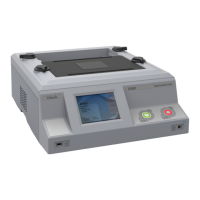C H A P T E R 7 – T E S T S A N D T E S T C O N D I T I O N S
AT5600 User Manual 98-119 issue 14 Page 106
7.10. D – Dissipation Factor or Tan
The parameter ‘D’ is most often used as a measurement of the losses in a
capacitor. It is analogous to Q for a transformer winding.
For this equivalent circuit the Dissipation Factor D is defined as:
D = Rs (where = 2f)
1/Cs
For a given capacitance, the lower the equivalent series resistance, the lower is
the value of the dissipation factor or tan, i.e. the 'better' the capacitor.
Where used
The dissipation factor test would normally be used for capacitors of all types. A D
factor test will help to determine that the capacitor has been manufactured
correctly.
Measurement conditions
To measure Dissipation Factor, the tester applies an AC voltage across the
selected winding and measures the voltage across and the current through the
winding. Using harmonic analysis, the measured voltage is divided by the current
to obtain a complex impedance from which the Dissipation Factor is obtained.
Choosing the test signal
For optimum accuracy and performance, use the test conditions chosen for
capacitance in a later section of this chapter.
Please also see
14.6.7 for specific advice on programming the test, and
10.2.3 for test accuracy specification

